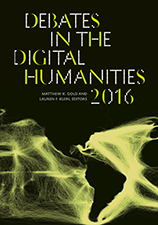Art history and visual culture DH (Digital Humanities)
FACES 2.0 is a face recognition application based on a method of machine learning known as a deep neural networking. Funded by the Kress Foundation, it is designed to automatically test the degree of probability of a shared identification between different works of portrait art—that is, non-photographic portraits that are subject to the subjectivity of artistic interpretation. Watch FACES: Faces, Art, and Computerized Evaluation Systems YouTube Video
Watch FACES: Faces, Art, and Computerized Evaluation Systems YouTube Video
Tools
DevDH.org - Development for the Digital Humanities: “Providing the intellectual and strategic scaffolding to aid DH researchers successfully complete their research endeavors.”
Scalar - Scalar is a free, open source authoring and publishing platform that’s designed to make it easy for authors to write long-form, born-digital scholarship online. Scalar enables users to assemble media from multiple sources and juxtapose them with their own writing in a variety of ways, with minimal technical expertise required.
QGIS is a free, open source, desktop software package that permits sophisticated management, analysis, and visualization of geographic data. (Its commercial equivalent is ArcGIS.)
Creating an Interactive Web Map with Carto - Maps are just a particular type of data visualization. Maps are good ways to learn about patterns and tendencies in your data, and later, to present the results of your research.
Books
A Digital Humanities Bibliography Compiled by John Taormina, Duke University With assistance from Alexander Strecker, Katherine McCusker, and Michael O’Sullivan,

Gold, Matthew K. and Lauren F. Kleun, Debates in the Digital Humanities 2016, 2016
Call #: AZ182.D44 2016
As digital humanities scholars and practitioners, along with their critics, continue to articulate the field, Debates in the Digital Humanities will track the issues and tensions at stake in their discussions of methods, practices, theories, controversies, projects, and politics.
Projects
Inventing Abstraction - Data visualization mapping the relationships among artists represented in the MoMA exhibition Inventing Abstraction 1910-1925.
Mapping Gothic France - The Mapping Gothic France project was initiated by Stephen Murray, Professor of Art History and Archaeology at Columbia University and Andrew Tallon, Assistant Professor of Art at Vassar College and funded through the generosity of the Andrew W. Mellon Foundation.
The Uffizi Digitization Project - Old Masters meet high tech in a new collaboration between Indiana University and the Uffizi Gallery that digitizes and catalogues the Florentine museum’s holdings online. The online works include 61 statues scanned and digitized by Indiana University students at the museum’s warehouse at Villa Corsini, where the Uffizi stores works that aren’t on display in its galleries.